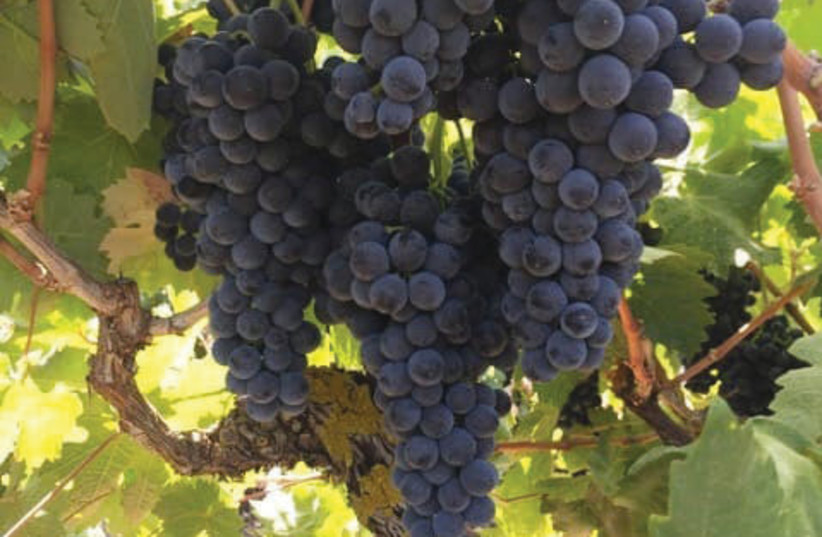In the spring of 1893, the first bottles of wine from the Carmel Winery in Israel were delivered to Jewish community centers in Russia and Poland. The Netziv of Volozhin (Rabbi Zvi Yehuda Berlin) was an elderly man living out the final months of his life in Warsaw. His son, Rabbi Meir Bar-Ilan, describes the Netziv’s reaction when the first bottle of Carmel wine was placed on his table.
“Despite his physical sickness, his eyes shone with joy. ‘Thank God that we have merited to drink the wine of Eretz Yisrael, from a vine planted by Jews in the land of Israel. It is a merit for us to eat from its fruit and enjoy its produce. Blessed is the one who has brought us to this day.’ His expressions of joy at enjoying the fruits of the Land of Israel continued for several days into Passover.”
Today, we take it for granted that we can eat fruits and drink outstanding wines of the Land of Israel. But it’s worth appreciating that this is the fulfillment of both prophecies and dreams.
It is a privilege to survey during the festival of freedom the most recent advances in Israeli winemaking.
First, bold grape growers and winemakers are cultivating new varieties of grapes that we have not seen in Israel before. One example of this is Dolcetto, a black wine grape from Piedmont in northwest Italy. Tura Winery in Samaria is the first Israeli winery to make wine from Dolcetto (blended with Marsalan). The resultant “Ridge” 2021 wine is delightful easy drinking with pronounced aromas and flavors, and it is very reasonably priced.


Teperberg has crafted the first Israeli Rose wine from Caladoc, a grape from Provence. (It is a cross between Malbec and Grenache.) The 2022 Essence series Rose is pale salmon in color, with wonderful aromas and flavors of strawberry, melon and apricot. Great fresh fruit with high acidity in an elegant bottle.
A second phenomenon in Israeli winemaking is the development of a first, formal Israeli “appellation,” which means a legally defined and protected geographical area with certain grape growing and winemaking traditions, and quality standards. This is a classic feature of the premier winemaking areas of Europe but never has been attempted in Israel.
The Judean hills and foothills is the first Israeli wine region to earn the status of Appellation of Origin (AO). There are some 30 wineries in these hills, divided into the distinct appellations of Judean, the lower Judean foothills, and Judean hills, named for elevations that are 400 m. high or more.
Wine producers can label their wines with this appellation if at least 85% of the grapes originate from the Judean hills and foothills region. “The Judean Hills Quartet” of Castel, Flam, Sphera and Tzora wineries were the pioneers here, along with Tzuba and others.
A third and growing phenomenon in Israeli winemaking is the move to Mediterranean varietals (grape types) that are uniquely suited to Israel’s hot climate. (This means a move away from the famous grapes from Bordeaux and Burgundy like Cabernet Sauvignon, Merlot and Chardonnay.)
Leading the way here has been Pierre Miodownick of Domaine Netofa Winery in the lower Galilee, with GSM blends (an acronym for Grenache, Syrah and Mourvedre – grapes native to the Rhone Valley, southern France, and hot climate locales in Spain and Italy). He produces high-end, sophisticated blends that can age for years, like Mourvedre and Syrah (Tel Qasser “Moursyr”) and Touriga Nacional and Syrah (“Tousyr”), from vineyards he planted and manages himself around Mount Tabor.
Lately, Pierre has returned to his French routes with a pet project under a new label called Nadiv. He does a twist on classic Bordeaux-style blending of Cabernet Sauvignon and Cabernet Franc grapes from the Judean Hills by adding Syrah from his Galilean vineyards to make a chewy and concentrated yet balanced wine.
Another outstanding Rhone-style winemaker is the sister Tulip and MAIA wineries led for years by winemaker David Bar-Ilan. (MAIA is an acronym for Mediterranean Approach Israeli Art.) The 2020 MAIA Grand Reserve wine blends Carignan, Syrah and Durif into an outstanding, full-bodied deep-purple wine with medium alcohol, medium-plus aromas and pronounced flavors of honeysuckle, red and black cherry, black pepper, charred wood, cooked plums, and something vegetal, with a long finish.
Carignan is a red grape variety of Spanish origin that is more commonly found today in wine from southern France, but it is widely planted throughout the western Mediterranean, and it goes back many years in the humid coastal plains of Israel. But only recently have good Carignan wines been produced here. Vitkin, Recanati and Jezreel wineries were the first to do so.
One of my favorites is Gross-Shoham Winery Onynx 2019, made from Carignan by wine master Oded Shoham. It has pronounced flavors of blueberry and plum, with high acidity and tannins that will work well alongside heavy stews.
A FOURTH development of note is grape growing and winemaking in the Negev. This is of extraordinary interest to European winemakers because climate change is raising temperatures and reducing rainfall everywhere, so much so that the most famous world wine professionals are coming to the Negev to see how things are done in a very arid region.
Even the unfriendly-to-Israel New York Times devoted a lengthy and nice story to this phenomenon. (See “Desert winemaking sounds absurd, but Israeli vineyards in Negev show the way: Israel’s arid South is testing ideas that might soon find global application,” September 7, 2022.)
Among the pioneers here are Ya’acov Oryah of Oryah and Pinto wineries of Yerucham, and Dana Berry of Nana Winery of Mitzpe Ramon. (Berry is moving this summer to Tulip Winery of the Galilee.) The Pinto Malbec 2021 (based on a grape that grows mainly in Mendoza in Argentina, originally from southwest France) is a masterpiece of fruit and spice with high tannins that characterize this grape.
A fifth phenomenon is the emergence of outstanding micro-producers, some of whom are going kosher for the first time. Two examples are HaSela Winery in the Ebay Hanahal town of southeastern Gush Etzion, and Naveh Winery, which is a subsidiary of the non-kosher Chateau Golan Winery.
Yoni Glustein and Eitan Lacks cultivate magnificent vineyards and run a beautiful visitor’s center for the boutique HaSela Winery. Their 2020 Cabernet Sauvignon (crafted together with winemaker Itzik Lotan) is balanced, has length, intensity, and complexity, and is overall outstanding with aging potential.
There is some spice, chocolate, and cedar on the secondary and tertiary palate. The ground in which their grapes are planted has a high PH, so the wine lacks some acidity, something which they can improve on by any number of winemaking methods.
Shmuel Koppel is the winemaker for the kosher Naveh wine, alongside Uri Chetz of Chateau Golan. His 2019 estate-grown Cabernet Sauvignon is rich and velvety drinking if you open the bottle several hours in advance to let it breathe. The alcohol is too high for my tastes, but that is the predicament of most Golan Heights wines these days.
In any case, the wine is not overpowering or bombastic like many current California or Australian Cabernets. Shmuel is a young winemaker with a great future. Perhaps he can drive Chateau Golan to become fully kosher too.
Sixth and finally, I recommend the following new wine book, written by my friend and master wine connoisseur Adam Montefiore (this newspaper’s longstanding and senior wine columnist): Domaine du Castel: The Biography. It tells the story of Eli Ben-Zaken of Castel and his family who single-handedly put Israeli winemaking on the world map in the late 1990s. Available for purchase from the winery. A great story, great winemaking education, and a book that will fill you with much pride about Israel.
The writer is studying for the International Wine & Spirit Education Trust Level 3 Award in Wine. According to Al-Jazeera he holds the distinction of being “drunk on Zion” and “wine-washing the occupation.” There are a few spots open on his post-Passover wine tour of the Galilee, April 16-18. See koshertravelers.com. His diplomatic, defense, Jewish world, and wine columns over the past 26 years are archived at davidmweinberg.com
